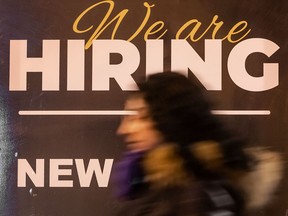Economists weigh in on the latest labour data
Article content
Canada’s unemployment rate continues to decline, falling to 6.6 per cent in January as the economy created more jobs than economists expected.
Article content
Article content
The economy added 76,000 positions, according to Statistics Canada’s latest labour force survey on Friday, beating estimates of 25,000 additions. Economists had also called for the jobless rate to rise to 6.8 per cent.
Advertisement 2
Article content
Canada’s jobless rate has fallen for two consecutive months, as it dropped to 6.8 per cent in December from a recent peak of 6.9 per cent in November. Prior to that, the unemployment rate had been on a steady rise from a post-pandemic low of 4.6 per cent in July 2022.
Market bets on a cut at the Bank of Canada’s March 12 meeting fell to 55 per cent from 80 per cent after the data.
Here’s what economists think the latest employment data means for the central bank and interest rates.
Four more cuts needed: Rosenberg Research
The impact from a weaker Canadian dollar was apparent in those sectors sensitive to currency swings, but David Rosenberg and Robert Embree at Rosenberg Research & Associates Inc. said the Bank of Canada’s rate cuts are also having an effect, particularly in the construction sector.
Nevertheless, the two economists said the latest labour data are weaker than at first glance, given that a larger share of the private-sector job gains came from part-time rather than full-time positions.
The unemployment rate may have fallen, but they warned that it remains well above the “neutral rate.” They said the slowing growth in wages also indicates there is plenty of slack in the labour market, and that’s something the Bank of Canada should be focused on.
Article content
Advertisement 3
Article content
“If the labour market was tight to any degree, compensation would not be moderating at all, let alone to this extent,” they said.
The Bank of Canada may have completed its “disinflation” journey, but with the economy still suffering from an output gap, the economists think policymakers need to cut four more times, regardless of what happens with tariffs.
‘Heady month of job creation’: Desjardins
“Amidst all the uncertainty about tariffs, the Canadian economy posted another heady month of job creation,” Royce Mendes, managing director and head of macro strategy at Desjardins Group, said in a note, referring to December when the economy added 91,000 jobs, which also handily beat economists’ estimates.
Most of the gains last month came from the private sector, adding to the “good news,” he said.
Total hours worked rose 0.9 per cent in January from December, boosting estimates for first-quarter growth to two per cent from 1.8 per cent.
The labour report provides the Bank of Canada with flexibility in uncertain times, Mendes said.
Policymakers could easily hold in March if tariffs are not implemented by the beginning of the month, Donald Trump’s newest deadline.
Advertisement 4
Article content
“Central bankers have some flexibility to respond if a shock hits the economy,” he said, given that inflation is hovering around the Bank of Canada’s two per cent target and hourly wage growth continues to slow, a metric policymakers have been closely tracking.
“Rates have risen across the Government of Canada yield curve and the Canadian dollar has appreciated in light of the surprisingly strong data.”
Permission to hold rates in March: Capital Economics
“You would struggle to find anything disappointing in the January Labour Force Survey,” Thomas Ryan, an economist at Capital Economics Ltd., said in a note, as job gains were racked up in the manufacturing and construction sectors, though the gain in the former could have been tariff-induced.
In January, job gains outpaced population growth, a sign that Ottawa’s new policy of cutting the number of international students and temporary foreign workers is working.
In previous labour force reports, employment gains typically fell short of monthly increases in population, helping to boost the unemployment rate.
Advertisement 5
Article content
“The only sign of relative weakness was the drop back in earnings growth to 3.5 per cent, but that will be welcome news for the (Bank of Canada) governing council given the recent pick-up in core inflation pressures,” Ryan said.
January’s job report gives the Bank of Canada permission to hold on rates in March, he said.
“We remain of the view the Bank (of Canada) will err on the dovish side of caution and reduce the policy rate by a further 25 basis points,” Ryan said.
Rates no longer a drag on economy: TD Economics
“Three consecutive months of solid job growth suggest the cyclical boost to Canada’s economy from lower interest rates is clearly taking effect,” Leslie Preston, managing director and senior economist at TD Economics, said in a note.
The Bank of Canada has reduced interest rates to three per cent from five per cent by implementing six consecutive cuts starting last June.
Preston thinks the current rate is “no longer” holding back the economy.
“Unfortunately, the imminent threat of tariffs hanging over the Canadian economy is likely to temper business confidence and could weigh on hiring in some sectors in the coming months,” she said.
Advertisement 6
Article content
After the Bank of Canada’s January rate cut, TD forecast that rates would fall to 2.25 per cent by year-end.
Recommended from Editorial
-

Canada’s unemployment rate drops to 6.6%
-

Macklem says tariffs would damage the ‘long-run prosperity’
Now, Preston seems to suggest that it’s just up to the monetary policy to guard the economy.
“Now it’s over to Canadian governments to do what they can to improve the competitiveness of the economy in the face of the tariff threat,” she said.
• Email: gmvsuhanic@postmedia.com
Bookmark our website and support our journalism: Don’t miss the business news you need to know — add financialpost.com to your bookmarks and sign up for our newsletters here.
Article content
Bank of Canada rate cut odds drop after jobs beat
2025-02-07 16:41:59






